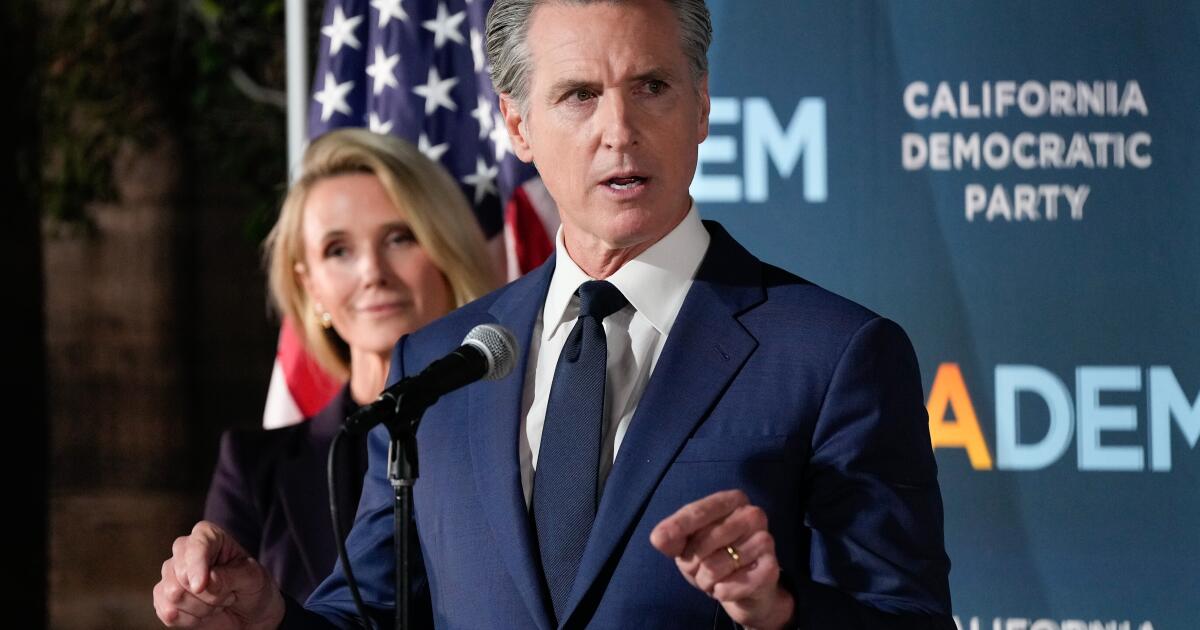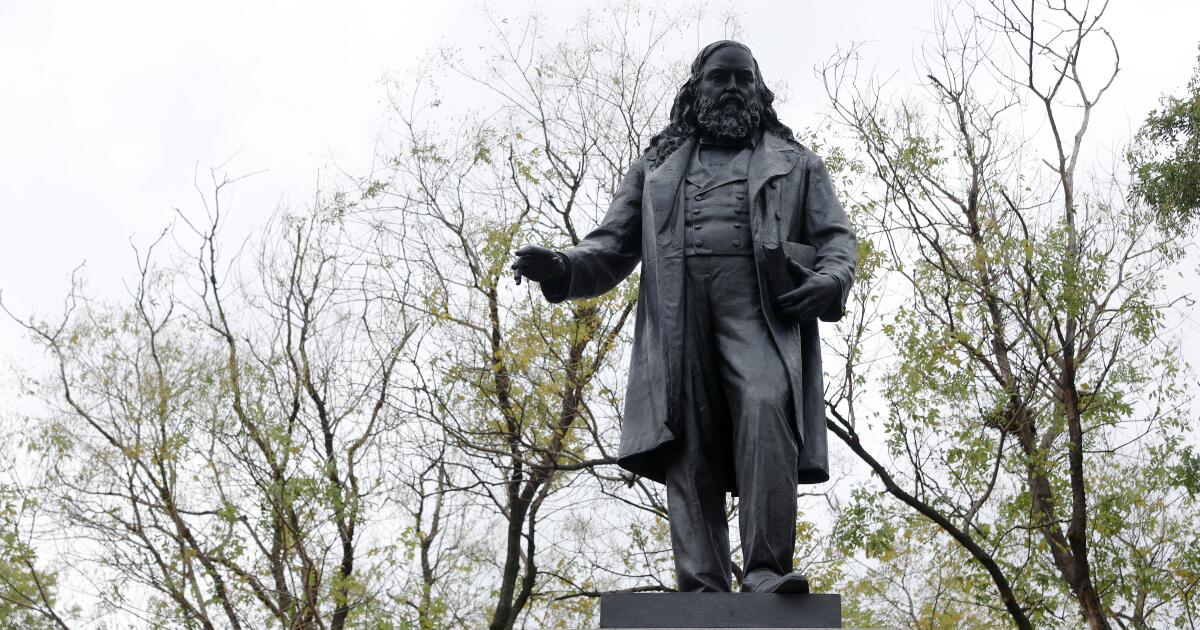Contributor: In recent Democratic wins, there are lessons for the GOP
Republicans are licking their wounds after Tuesday’s ballot box defeats. But there is a lesson to be learned here. The various elections in New York City, New Jersey and Virginia, viewed collectively, reminded us yet again of a perennial political truth: Americans still care first and foremost about their wallets.
Culture war-type issues often generate the most salacious headlines — and many of the Trump administration’s fights on these fronts, such as immigration enforcement and higher education reform, are just and necessary. Still, the economy remains the top political issue. Unless Republicans get more serious about advancing an actionable economic agenda to provide real relief to middle- and working-class Americans, the party risks losing even more ground in next year’s midterm elections.
When voters went to the polls in New York City, New Jersey and Virginia, they were often asking the simplest, most urgent questions: Can I pay the rent? Can I fill up my truck at the pump? Can I fill the fridge? Will my job still exist next year? Do I have reliable healthcare for my children? Across too many districts and communities, those answers remain uneasy. Inflation, while well down from its Biden-era peak, is still stubbornly higher than the Fed’s 2% target. Purchasing power is still eroded, and cost-of-living anxieties persist for far too many.
For Republicans, this is both a warning and an opportunity. Despite a concerted effort in recent years to rebrand as the party of the common man, including but hardly limited to Teamsters President Sean O’Brien getting a coveted speaking slot at last year’s Republican National Convention in Milwaukee, too many voters still associate the GOP with tax cuts for the donor class and a general indifference toward the tens of millions of Americans who live paycheck to paycheck. That’s the blunt truth. The perception of corruption in some of the highest corridors of power in Washington, especially when it comes to the influence wielded by the über-wealthy emirate of Qatar, doesn’t exactly assuage voters’ concerns.
If the GOP wants to regain the public’s trust, it must present a compelling vision of what a sound conservative economic stewardship entails in the 21st century.
That redefinition begins with a renewed focus on work, dignity and resilience. The Republican Party must build an economic narrative that centers on taming inflation, boosting wages, rebuilding America’s industrial base and greater healthcare security for the paycheck-to-paycheck class. Conservatives should pursue a pragmatic economic nationalism — one that ties together trade policy, manufacturing, energy production, workforce development and family formation. All proposed economic policies must be explained in concrete, local terms. The relevant questions each and every time should be: How does this policy tangibly benefit the average American, and how can the policy be messaged so that the benefit is clearly understood?
The voters Republicans need to reach are not tuning in to wonky policy seminars. They want results: lower energy bills, affordable groceries, job security and an economy that rewards hard work. The GOP must speak directly to these priorities with honesty and humility.
If economic anxiety persists through next fall’s midterms, voters will punish whichever party appears more indifferent to their struggles. The Trump administration and Republicans across the country need to get to work fast. That means more Trump-signed executive orders, within the confines of the law, that can provide real economic relief and security to the working men and women of America. And it certainly means a concerted congressional attempt to bolster the economic prospects of the middle and working classes, perhaps through the Senate’s annual budget reconciliation process.
Inflation must finally be tamed — including the Fed raising interest rates, contra Trump’s general easy-money instincts, if need truly be. Private health savings account access must be expanded and the ease of acquiring private healthcare must finally be divorced from the particular circumstances of one’s employment. More jobs and supply chains must be reshored. Concerns about child care affordability and parental leave availability must be addressed. And even more of our bountiful domestic energy must be extracted. These are just some of the various policies that voters might reward at the ballot box next fall.
Our searing cultural battles will continue — and they matter, greatly in fact. But when a family can’t afford its groceries or gas, such debates tend to fade into the background. Republicans must rebuild trust with voters on the most fundamental issue in American politics: the promise of economic opportunity and security.
It’s always dangerous to over-extrapolate and glean clear national lessons from a few local elections. But all three of the biggest recent races — for New York City mayor and for New Jersey and Virginia governors — had final winning margins for Democrats greater than most polling suggested. That seems like a clear enough rebuke. Accordingly, the Trump administration and Republicans across the country must deliver real economic results on the real economic issues facing the American people. If they don’t present a compelling economic vision and execute that vision capably and efficiently, there likely will be even greater electoral damage next fall.
That could all but doom the remainder of the Trump presidency. And what a disappointment that would be.
Josh Hammer’s latest book is “Israel and Civilization: The Fate of the Jewish Nation and the Destiny of the West.” This article was produced in collaboration with Creators Syndicate. X: @josh_hammer
Insights
L.A. Times Insights delivers AI-generated analysis on Voices content to offer all points of view. Insights does not appear on any news articles.
Viewpoint
Perspectives
The following AI-generated content is powered by Perplexity. The Los Angeles Times editorial staff does not create or edit the content.
Ideas expressed in the piece
Republicans should prioritize economic relief for working and middle-class Americans above cultural disputes, focusing on concrete issues that voters care about most, such as inflation, job security, healthcare costs, and purchasing power[1]. The GOP must build an economic narrative centered on taming inflation, boosting wages, and rebuilding America’s industrial base through pragmatic economic nationalism that ties together trade policy, manufacturing, energy production, and workforce development[1]. Specific policies should address childcare affordability, parental leave availability, expanded health savings account access, reshoring of jobs and supply chains, and increased domestic energy production[1]. The Trump administration should pursue executive orders and congressional action through the budget reconciliation process to deliver tangible results on these economic priorities[1]. Republicans have historically struggled with voter perception of favoring tax cuts for the wealthy, and must rebuild trust by demonstrating genuine commitment to economic opportunity and security for the paycheck-to-paycheck class[1]. Without real economic results before the midterm elections, Republicans risk greater electoral damage and could jeopardize the remainder of the Trump presidency[1].
Different views on the topic
Conservative economic policies have historically prioritized wealthy interests over working-class security, with tax cuts for corporations and the wealthy producing short-term gains followed by economic stagnation, downturns, and larger deficits[4]. Democratic administrations have consistently outperformed Republican ones across nearly every measure of economic performance, including job growth, unemployment, economic growth, and manufacturing growth, with Democrats adding 50 million jobs since the early 1980s compared to 17 million under Republicans[4]. Project 2025, a comprehensive Republican policy agenda, would shift tax burdens from the wealthy to the middle class through a two-tier tax system, lower the corporate tax rate from 21 to 18 percent, and strip workers of protections by making fewer workers eligible for overtime pay while weakening child labor protections[2][5]. The Trump administration’s economic policies, including haphazard tariffs and reduced support for working families, have contributed to a weakening economy[6]. Wealth inequality remains staggeringly high and repugnant to most Americans, increasingly associated with conservative fiscal policies that reward predatory financialization at the direct expense of social safety nets[3].





